Water | Term 3 Unit 2 | 6th Science - Questions Answers | 6th Science : Term 3 Unit 2 : Water
Chapter: 6th Science : Term 3 Unit 2 : Water
Questions Answers
Evalution
I. Choose the appropriate answer
1. Around 97% of water available on earth is__________
water.
a. fresh
b. pure
c. salty
d. polluted
Answer: c) salty
2. Which of the following is not a part of
water cycle?
a. evaporation
b. condensation
c. rain
d. distillation
Answer: d) distillation
3. Which of the following processes add water
vapour to the atmosphere?
i. Transpiration
ii. Precipitation
iii. Condensation
iv. Evaporation
a. ii and iii
b. ii and iv
c. i and iv
d. i and ii
Answer: c) i and iv
4. About 30% of the fresh water is found in?
a. glaciers
b. ground water
c. other sources of
water
d.0.3%
Answer: b) ground water
5. Using R.O. plant at home eliminates lot of
non-potable water. The best way to effectively use the expelled water of R.O.
plant is __________
a. make the
expelled water go and seep near the bore well
b. use it for
watering plants
c. to drink the
expelled water after boiling and cooling
d. to use for
cooking as the water is full of many nutrients
Answer: b) use it for watering plants
II. Fill in the blanks
1. Only 0.3 percent of natural water is available for human consumption.
2. The process of
changing water into its vapour is called evaporation.
3. Dam is
built on rivers to regulate water flow and distribute water.
4. Water levels in
rivers increase greatly during rainy season.
5. Water cycle is also called as Hydrological cycle.
III. True or False. If False, give the correct statement
1. Water present in
rivers, lakes and ponds is unfit for use by human beings.
Water present in lakes, rivers and pond is fit for use
by human beings. It is used for wasting, bathing and irrigation. It is purified
and made fit for drinking.
2. Seas are formed
when the water table meets the land surface.
Springs are formed when
the water table meets the land surface.
3 The evaporation
of water takes place only in sunlight.
4. Condensation
results in the formation of dew on grass.
5. Sea water can be
used for irrigation as such.
As sea water is salty
it cannot be used for irrigation as such.
IV. Match the following
1. Flood - Lake
2. Surface water -
Evaporation
3. Sun light -
Water vapour
4. Cloud - Pole
5. Frozen water -
Increased rain fall
Answer:
1. Flood - Increased rain fall
2. Surface water - Lake
3. Sun light - Evaporation
4. Cloud - Water vapour
5. Frozen water - Pole
V. Arrange the following statements in correct
sequence
1. These vapours
condense to form tiny droplets of water.
2. The water
droplets come together to form large water droplets.
3. The heat of the
sun causes evaporation of water from the surface of the earth, oceans, lakes,
rivers and other water bodies.
4. The large water
droplets become heavy and the air cannot hold them, therefore, they fall as
rains.
5. Water vapour is
also continuously added to the atmosphere through transpiration from the
surface of the leaves of trees.
6. Warm air
carrying clouds rises up.
7. Higher up in the
atmosphere, the air is cool.
8. These droplets
floating in the air along with the dust particles form clouds.
Answer:
1. The heat of the sun
causes evaporation of water from the surface of the earth, oceans, lakes, rivers
and other water bodies.
2. Water vapour is also
continuously added to the atmosphere through transpiration from the surface of the
leaves of trees.
3. These droplets floating
in the air along with the dust particles form clouds.
4. Warm air carrying
clouds rises up.
5. Higher up in the
atmosphere, the air is cool.
6. These vapours condense
to form tiny droplets of water.
7. The water droplets
come together to form large water droplets.
8. The large water droplets
become heavy and the air cannot hold them, therefore, they fall as rains.
VI. Analogy
1. Population explosion : Water scarcity :: Recycle : water management.
2. Ground water : wells :: Surface water : lakes
VII. Give very short answer
1. Name four different sources of water
Wells, lakes, dams, rivers.
2. How do people in cities and rural areas get
water for various purposes?
They get water by pumping out ground water using borewells. Water
obtained from wells, borewells, rivers and lakes is purified and distributed to
the people in cities and rural area.
3. Take out of cooled bottle of water from
refrigerator and keep it on a table. After some time you notice a puddle of
water around it. Why?
The water vapour in the air around condenses when it touches the
cooled bottle. The droplets of water formed on the outside of the bottle get accumulated
and become large drops. They drip down the sides of the bottle and fall to the bottom
as a puddle of water.
4. We could see clouds almost every day. Why
doesn’t it rain daily?
Rain falls only when the air around the cloud is cool enough to change
water vapour into water drops. When there is no cool air around the clouds there
won't be any rain.
5. Name the places where water is found as ice.
Water is found as ice on high mountains and in polar regions.
6. How do aquatic animals manage to live in
Arctic and Antarctic Circle?
The aquatic animals in Arctic and Antarctic region have thick fur
on their skin and a thick layer of coat beneath. The fur and the fat protect the
animals from extreme cold. These animals burrow into snow and hide into it. The
snow acts as an insulator and prevents the entry of cool air in.
7. What are the types of rain water harvesting?
(a) Collecting rain water from where it falls.
(b) Collecting flowing rain water.
VIII. Give short answer
1. Differentiate between surface water and
ground water.
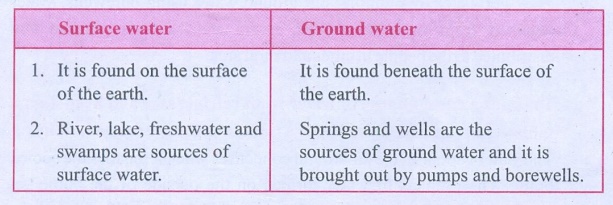
Surface water
1. It is found on the surface of the earth.
2. River, lake, freshwater and swamps are sources of surface water.
Groundwater
1. It is found beneath the surface of the earth.
2. Springs and wells are the sources of ground water and it is brought
out by pumps and borewells.
2. Write a few slogans of your own on the topic
“Save Water”.
1) Conserve water, that is right
Or else future, full of fright.
2) Waste not water, save it now.
Future of man, if you love.
3. About 71% of earth’s surface is covered with
water, then why do we face scarcity of water?
97% of water present on earth is found in seas and oceans. As it
is salty we cannot use it for drinking or irrigation. There is only 3% of fresh
water. Of this, 68.7% is present as ice and glaciers in the poles. We can use only
the remaining water. Owing to population explosion we need more water as days pass
by but there is only a fixed quantity of water on earth. The availability of water
cannot be increased by any means. So we face water scarcity.
4. Give reason for the following statement –
Sewage should not be disposed of in rivers or oceans before treatment.
Sewage contains toxic chemicals. If it is disposed of in rivers and
oceans, it will kill the aquatic animals. So the sewage water should be properly
treated before it is disposed of.
5. The fresh water available on earth is only
3%. We cannot increase the amount of water. In that case, how can sustain the
water level?
Human activities like pollution, usage of plastics and destruction
of water sources for construction purposes and sinking borewells cause the lowering
of groundwater level. So we should restrict the above mentioned activities. We should
pay more attention to conservation of water like rain water harvesting. We should
prevent wastage of water by adopting techniques as drip irrigation and recycling
of water. Awareness should be created among people to put an end to wastage of water.
IX. Answer in detail
1. What is potable water? List down its
characteristics.
Potable water is drinking water safe for human beings. It does not
cause any harm to the drinker. It is supplied to houses by means of taps as drinking
water. The intake of drinking water is related to one's age, nature of work and
his health condition. Potable water has three characteristics (i) Physical (ii)
Chemical (iii) Microbiological.
The metal particles in potable water and the solids dissolved in
it (TSS - Total Suspended Solids) are physical characteristics.
The dissolution of Nitrate, Nitrite, Arsenic etc in potable water
determine its chemical characteristics. The micro organisms found in potable water
constitute its microbiological characteristics. The bacteria and virus in potable
water cause diseases as cholera and diarrhoea.
2. Who is known as waterman of India? Browse
the net and find the details about the award, the waterman received for water
management. State the findings by drafting a report.
Dr. Rajendrasingh of Rajasthan is regarded as the 'Waterman of India'.
He is a conservationist and environmentalist of our times.
The Avari River in Northwest Rajasthan did not flow for sixty years.
Thanks to the initiative and effort taken by Dr. Rajendrasingh the river started
flowing and now it is a perennial river.
Dr. Rajendrasingh learned the ancient practice of building dams called
' Johads'. During rainy season he stored the rain water. Working hard for 10-14
hours a day he succeeded in rain water harvesting. With the help of the community
Dr. Rajendrasingh constructed 375 Johads. So the Avari River started flowing in
1995. Because of his efforts on conservation more than 1000 villages have been benifitted.
Forests began to appear anew.
In 2001 Dr. Rajendrasingh was awarded Ramoan Magsaysay Award. It
is Asia's highest honour. In 2015 he was awarded Stockholm Water Prize. It is equivalent
to Nobel Prize for water.
3. What is rainwater harvesting? Explain in a
few sentences how it can be used in houses.
Direct collection and use of rain water is called rainwater harvesting.
There are two types of rainwater harvesting.
(a) Collecting water
from where it falls.
(e.g): Collecting water
from the roof tops of the houses or buildings
(Roof water harvesting).
(b) Collecting flowing
rain water.
(e.g): Collecting rainwater
by constructing ponds with bund.
X. Question based on Higher Order Thinking Skills
1. When there is no pond or lake in an area,
will there be formation of clouds possible in that area?
When there are no ponds or lakes in an area there won't be evaporation
of surface water. So clouds cannot be formed above these places.
2. To clean the spectacles, people often
breathe out on glasses to make them wet. Explain why do the glasses become wet.
When we breathe out on glasses, the water vapour in our breath sticks
to the glass. It gets condensed on the cool surface of the glass. The moisture thus
formed helps us to clean the glass.
XI. CROSSWORD
DOWN
1. A method of water
conservation.
2. Process of getting
water vapour from sea water.
6. Water stored in
dams is used for generation of __________
ACROSS
3. __________is a large body of non-potable
water found in nature.
4. In summer, the body loses water as __________
5.
Plants undergo__________ and contribute
to water cycle.
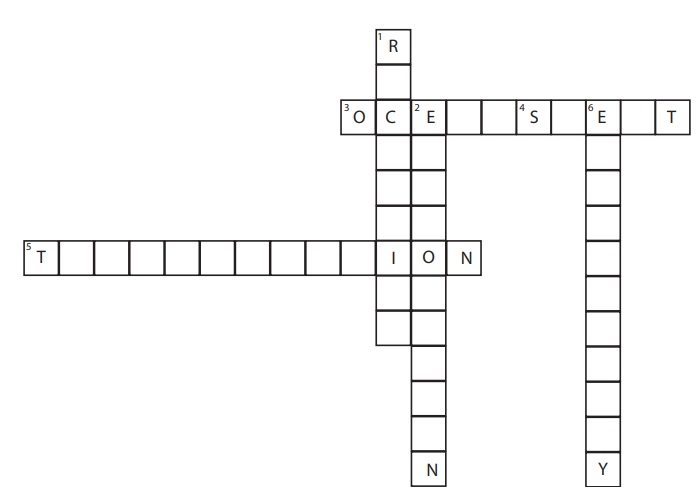
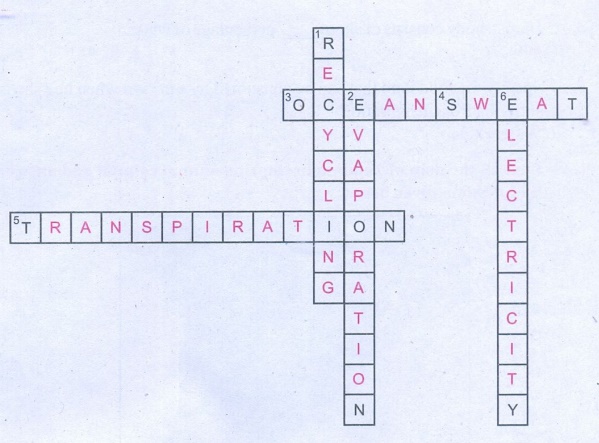
XII. (1). Observe the given graph carefully
and answer the questions.
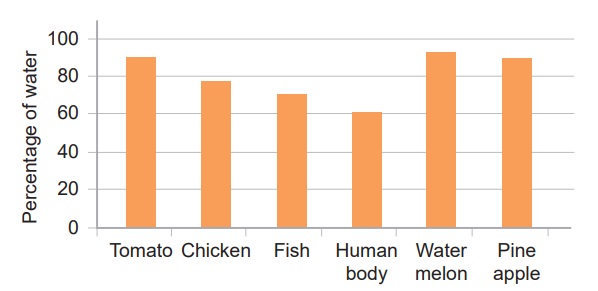
a. What percentage of water is seen in fish?
70%
b. Name the food item that has maximum amount
of water in its content.
Water melon
c. Name the food item that has minimum amount
of water in its content.
Fish
d. Human body consists of about percentage of water.
60
e. Specify the food item that can be consumed
by a person when he / she is suffering from dehydration.
Watermelon
2. Look at the map of Tamilnadu showing annual rainfall
and answer the questions given
a. Identify the districts that get only low
annual rainfall in Tamilnadu.
Dharmapuri, Erode, Karur, Trichy, Perambalur, Tanjore, Pudukottai,
Sivagangai, Madurai, Dindigul, Ramanathapuram.
b. Identify the districts that get a medium annual rainfall in
Tamilnadu.
Thiruvallur, Chennai, Kancheepuram, Krishnagiri, Vellore, Thiruvannamalai,
Villupuram, Salem, Namakkal, Tirupur, Ariyalur, Thiruvarur, Virudhunagar, Tuticorin.
c.
State
the districts that enjoy high annual
rainfall in Tamilnadu.
Nilgiri, Coimbatore, Theni,
Thirunelveli, Kanyakumari, Cuddalore, Nagapattinam.
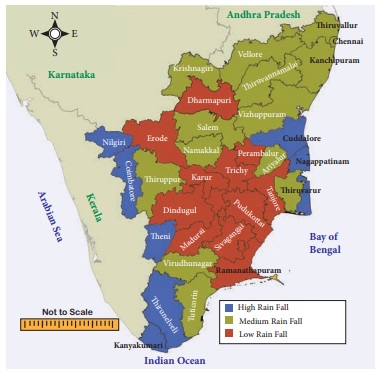
Related Topics